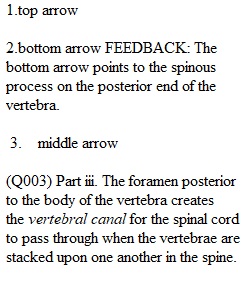


Q Question 1 1 / 1 pts (Q001) This exercise is to help you begin to understand the terminology we use to identify the general landmarks and features on bones (you will learn the specific bones of the skeleton and their features in greater detail in Lab 6). Use the pictures in the Lab 5 Exercise Image Library on pp. 131-132 of your lab manual to complete the following tasks. Examine the cervical vertebra (neck vertebra) depicted on p. 131 of your lab manual. Locate the features boldfaced and described in Parts i-iii, and indicate which arrow on the image on p. 131 points to each feature. Part i. The transverse foramen (one on each side of the vertebra) transmits the vertebral arteries that send blood to the brain. Correct! Question 2 1 / 1 pts (Q002) Part ii. The posterior end of the vertebra has a spinous process to which muscles and ligaments attach. Question 3 1 / 1 pts (Q003) Part iii. The foramen posterior to the body of the vertebra creates the vertebral canal for the spinal cord to pass through when the vertebrae are stacked upon one another in the spine. Question 4 1 / 1 pts (Q004) Examine the humerus (upper arm bone) depicted on p. 131 of your lab manual. Locate the features boldfaced and described below in Parts iv-vi, and indicate which arrow on the images on p. 131 points to each feature. Part iv. On the posterior side of the distal end of the humerus, there is a feature called the olecranon fossa. This is where the elbow-forming projection of the ulna (one of the lower arm bones) sits when the lower arm is extended.
View Related Questions